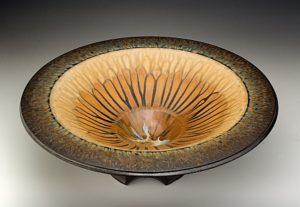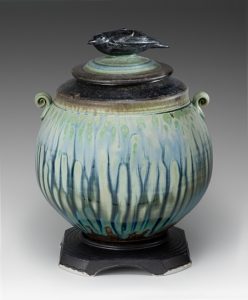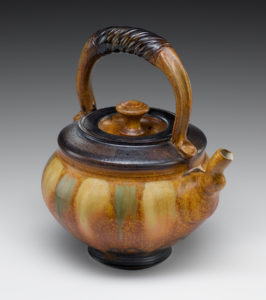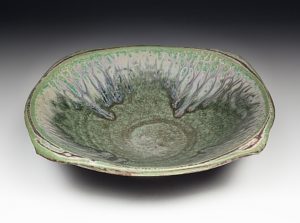The Potter and the Clay
In the turmoil of the 2000 degree heat,
Richard Aerni creates his “quiet, harmonious” pottery
By Kathy Hovis-Younger
Richard Aerni wipes his brow as he reaches for the red hot brick and reveals the inside turmoil of a kiln burning at about 2000 degrees. The brick monster, spewing steam and flames from its edges, still has a few hours to go before it reaches its maximum temperature and bakes his clay creations to perfection.
Only a few weeks earlier, these pieces were mushy, malleable lumps of clay in his workshop-garage next door. “To be a potter you’ve got to be someone who likes to work in the mud, and also part chemist,” he says, his blue shorts and gray T-shirt revealing his animosity toward corporate life. He proudly shows off racks stacked to the ceiling in his pole barn with finished work.
The creations won’t be there long, says the East Bloomfield potter, who smiles when he says for the last three years he hasn’t been able to keep up with the demand. His life is pretty fine, he says. He sets his own schedule and is able to hang around home with his wife, April, a teacher at Nazareth College, and 5 year-old son Charley.
 A vase of brilliant tall flowers graces the table in the family’s bright white kitchen, which Aerni frequents as the family chef. And pieces of his work, as well as the pottery of others, can be seen on the walls, in cupboards, on shelves. “This is a great lifestyle,” the 41 year old says. “I’m kind of a homebody and I like to be there to share in Charley’s life.”
A vase of brilliant tall flowers graces the table in the family’s bright white kitchen, which Aerni frequents as the family chef. And pieces of his work, as well as the pottery of others, can be seen on the walls, in cupboards, on shelves. “This is a great lifestyle,” the 41 year old says. “I’m kind of a homebody and I like to be there to share in Charley’s life.”
Not to say that his occupation is not demanding. Aerni says he now works about 60 hours a week, as opposed to the 80-100 hour schedule he has been known to keep. He’ll often spend all day in his shop and pole barn until Charley gets home from school, then head out again to his shop after dinner, sometimes until the wee hours.
As he speaks, Charley runs in with a friend, then shimmies over to the stairs. “I got into this to get away from the corporate world, but this is really business,” he says. “You’ve got to have a good business sense.” Over the last few years, he has learned more about marketing, selling and networking, as well as which shows to visit and what kind of pieces seem to sell best. He’s also learned more about the art itself. And now the confidence of a businessman-artist-family guy shows through, even though his shorts and fingernails may contain bits of mushy clay.
Life wasn’t always so comfortable for Aerni, who moved to East Bloomfield in 1987 fro m Cincinnati when his wife was offered the Nazareth job. Trained as a geologist, he found few careers in the field worth pursuing. Instead, he made a living from various part-time jobs. He met April when he was living in a condemned Cincinnati building. She worked with the city planning department. “I lived in the slums, and she was trying to oversee their development” into something attractive, he said.
m Cincinnati when his wife was offered the Nazareth job. Trained as a geologist, he found few careers in the field worth pursuing. Instead, he made a living from various part-time jobs. He met April when he was living in a condemned Cincinnati building. She worked with the city planning department. “I lived in the slums, and she was trying to oversee their development” into something attractive, he said.
After taking one six-session class in pottery, he fell in love with the art, but hasn’t had any other formal training. “Everything else I’ve learned from other people, from books or from my own mistakes,” he says. In 1978, working during the day and making pottery at night, Aerni came to the realization he had to pursue his craft full time to see if he could make it.
When he had saved enough money to live for a year, he gave up his day jobs and committed his hours to his art. “I decided if I didn’t make it by the end of the year,” then he would quit. But he made it, opened a studio with a partner and pottery has been his full-time pursuit ever since. Calling himself a traditional potter, Aerni says his work is influenced by Oriental potters and the classic shapes they create.
His pieces are single-fired, unlike many potters who fire once, then glaze and fire again. Aerni makes his own glazes from wood ash, which he collects from neighbors and friends, rewarding them with a bowl, vase or other piece. He mixes the ash with various pigments—feldspar, copper, cobalt—then tosses the glaze on each pot before it is fired. The glaze melts and spreads over the pot, creating his signature design. As a result of the single firing, Aerni says he’s never exactly sure what each piece will look like until it emerges from the kiln.
His pieces are meant to be functional, as well as decorative, but “they’re not the kind of things that take over a room,” he says, preferring to describe his work as “quiet” and “harmonious.” One challenge is achieving a balance between doing large numbers of pots that sell well and venturing out with new designs. “I don’t have as much time to experiment as I might like,” he says, but he does introduce three to four new pieces each year.
as decorative, but “they’re not the kind of things that take over a room,” he says, preferring to describe his work as “quiet” and “harmonious.” One challenge is achieving a balance between doing large numbers of pots that sell well and venturing out with new designs. “I don’t have as much time to experiment as I might like,” he says, but he does introduce three to four new pieces each year.
Aerni’s fan club extends farther than the 60 shops and galleries he sells to and the people who buy his work at art shows, which, these days, he limits to one or two each year. His work has been recognized by the Smithsonian Institute, which included several of his pots in its permanent collection of American arts and crafts. And he’s won awards at art shows including Rochester’s Clothesline show and the Waterfront Arts Festival at Kershaw Park in Canandaigua.
And along with his art, Aerni says he finds satisfaction being a part of the East Bloomfield community. He is a member of the library board of trustees and is on the school restructuring committee. “I don’t want this to sound arrogant,” he says, one shoe resting on the rungs of a kitchen chair as he bows his head slightly, “but I’ve always done what I wanted to do. I always pursued the things that interested me.”
And, for now, one of those interests lies baking in a red-hot kiln, while the other two sit wondering what he’s planning for dinner tonight.
